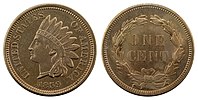Wikipedia:Today's featured article/March 2, 2018
The Indian Head cent is a penny ($0.01) that was produced by the U.S. Bureau of the Mint from 1859 to 1909. It was preceded by the large cent (1793–1857), a copper coin about the size of a half dollar, and the Flying Eagle cent. The large cent was discontinued after a rise in the price of copper in the wake of the California Gold Rush (1848–1855). The 1857 Flying Eagle is identical in diameter to the modern U.S. cent, but thicker, with a composition of 12% nickel and 88% copper. The Indian head cent, designed by James Barton Longacre, the Chief Engraver at the Philadelphia Mint, was initially the same size as the Flying Eagle. Cents were hoarded during the economic chaos of the American Civil War, when nickel was in short supply, and privately issued bronze tokens began to circulate until Congress authorized a thinner cent of bronze alloy. After the war the cent became popular, and even more so with the advent of coin-operated machines in the late 19th and early 20th centuries. In 1909, the Indian Head cent was replaced by Victor D. Brenner's Lincoln cent. (Full article...)
